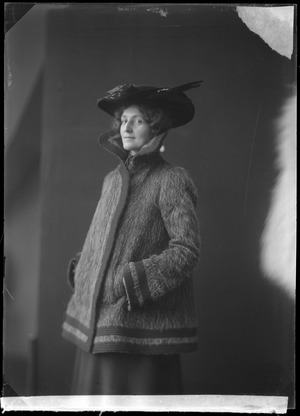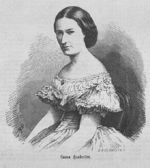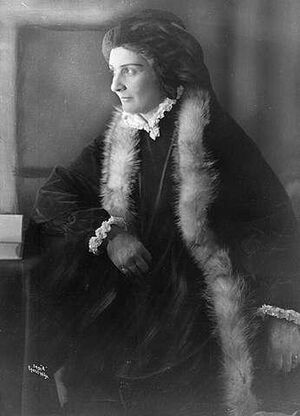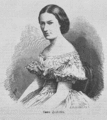Agnes Mowinckel facts for kids
Quick facts for kids
Agnes Mowinckel
|
|
|---|---|

Mowinckel c. 1905
|
|
| Born |
Agnes Mowinckel
25 August 1875 Bergen, Norway
|
| Died | 1 April 1963 (aged 87) Oslo, Norway
|
| Occupation |
|
| Years active | 1899–1963 |
| Spouse(s) |
Hans Brecke Blehr
(m. 1899; div. 1909) |
| Children | 3 |
Agnes Mowinckel (born August 25, 1875 – died April 1, 1963) was a famous Norwegian actress and theatre director. She was born in Bergen, Norway. Agnes became Norway's very first professional stage director.
She was a true pioneer in theatre. Agnes brought painters to the stage and used light in new artistic ways. She also worked with modern music composers. Agnes loved trying new things in theatre. She worked at small theatres in Oslo and even started her own theatre company.
Her first play as a director was Spring Awakening in 1922. After that, she directed many plays for Det Norske Teatret. From 1927 to 1928, she led an exciting new theatre called Balkongen in Oslo. She also directed the first play at Det Nye Teater in 1929. In the 1930s, she directed many shows at the Nationaltheatret and Det Norske Teatret. Even in her seventies, after World War II, she helped create new theatres like Studioteatret and Folketeatret. She was known for her strong and lively personality.
As an actress, Agnes often played the main characters. She started her acting career in 1899 at Den Nationale Scene in Bergen. She later joined Sekondteatret. After a break, she returned to acting in 1909. She toured with a theatre group and performed in Trondheim. In the mid-1910s, she even acted in some Danish films. She regularly performed at Centralteatret and Det Nye Teater.
Contents
Agnes's Early Life and Family
Agnes Mowinckel was born into an important family in Bergen. Her parents were Edward Christian Mowinckel and Cornelia Schultz Blydt. She grew up with eight brothers and sisters. Her family had a long history in business.
Her oldest brother, Johan Ernst, was a merchant and a leading politician. He supported Agnes when she decided to become an actress. He also helped her financially, paying for her trips to England and Paris. Her brother Harald took over the family business, which was one of Norway's biggest fish exporters. Her sister Johanne Vogt was one of the first women to serve in the Norwegian Parliament.
Agnes was also related to Prime Minister Johan Ludwig Mowinckel. She was married to Hans Brecke Blehr from 1899 to 1909. They had three children together. Later, she became close friends with Sigurd Bødtker, a theatre critic. They eventually lived together.
In 1917, Agnes bought a summer house on the island of Hvasser. She called it "Abergeldie." This house became a popular meeting place for her friends, especially painters and writers.
Agnes's Theatre Career
Starting Out in Theatre
In 1894, when Agnes was 19, she moved to Kristiana to study drawing. There, she became friends with Laura Gundersen, a leading actress at the Christiania Theatre. Agnes often visited Laura's home and helped her study plays. Agnes also met many artists in Kristiania who later became part of her social circle.
After a year, Agnes returned to Bergen. She worked as a teacher and took acting lessons. She made her first stage appearance on January 2, 1899. She played "Anna Hielm" in a play called Kong Midas. She was offered a job at the theatre in Bergen but chose to join Sekondteatret in Kristiania instead.
In October 1899, Agnes married Hans Blehr. They had two children, Hans and Karen Lisbeth. Their large home became a gathering spot for artists and writers. Agnes first performed at Nationaltheatret in 1902. She filled in for another actress in the play Fru Inger til Østeraad.
Returning to the Stage in 1909
In 1909, after ten years as a mother and housewife, Agnes separated from her husband. She needed a place to live, money, and a job. So, she joined a touring theatre group called Nationalturneen for the 1909/1910 season. She acted and was in charge of costumes.
She played the main character in Revolusjonsbryllup and was praised for her role in Daniel Hertz. From 1911, she worked at Trondhjems nationale Scene for one season. She played "Borghild" in Sigurd Jorsalfar and "Elida Wangel" in Ibsen's Fruen fra havet.
In 1912, Agnes visited London and Paris. These trips greatly influenced her future work as a director. In London, she was inspired by Edward Gordon Craig's ideas about stage design and lighting. In Paris, she learned from Charles Dullin how to combine drama with music and painting. In the 1910s, she also acted in a few Danish films.
When she returned to Kristiania, her home became a lively meeting place. Many writers and artists visited her. They often met at a restaurant called Anden Etage. Agnes always dressed carefully, often in clothes and hats she designed herself.
At Centralteatret in 1916, she played the main character in Fru Ynske. She also played "Rosa Mamai" in L'Arlésienne. In 1919, her performance as "Mrs. Alving" in Ibsen's Ghosts was highly praised. In 1921, her role as the main character in Ibsen's Fru Inger til Østeraad was very popular.
Becoming a Stage Director in 1922
In 1922, Agnes Mowinckel directed her first play, Spring Awakening, at Intimteatret. The audience loved it and gave her a standing ovation. This play was special because it was the first time Edvard Munch's paintings were used on a Norwegian stage. Many people saw this as a very important moment in Norwegian theatre history. Agnes was praised for her artistic vision, especially how she blended stage decorations, costumes, lighting, and movement.
Agnes directed 28 plays for Det Norske Teatret. She was known for bringing new European plays to this theatre. Her first production there was Myrkemakti in February 1923. After this, she became a stage instructor for the theatre for two years. She directed many successful plays, including Kjærleik på Lykteland, which was a big hit. In 1924, she also directed and acted in Dangardsfolket.
Working at Nationaltheatret (1925–1926)
In 1925, Agnes was hired as a permanent stage director for Nationaltheatret. Her first play there, Outward Bound, was a success. However, her next play, Ibsen's Little Eyolf, faced problems. One of the main actresses, Johanne Dybwad, refused to work with her. The play was then cancelled.
Agnes directed other plays like Swedenhielms and Edmund Jahr. Her production of Shaw's Jeanne d'Arc was not as successful as hoped. After this, some people at the theatre blamed Agnes and asked for her to be fired. Agnes left the theatre that same day. It would be seven years before she directed another play at Nationaltheatret.
Leading Her Own Theatre: Balkongen (1927–1928)
After leaving Nationaltheatret, Agnes Mowinckel started her own theatre in 1927. She called it Balkongen. It was located in an old concert hall. Her first play there was Hevnens gud. She also directed other important plays, including Ibsen's Fruen fra havet.
Later Career in the 1920s and 1930s
In 1928, Agnes played "Lady Inger" at Centralteatret. She directed Frå fest til fest and Plogen og stjernone for Det Norske Teatret. She also acted and directed in Ibsen's Et dukkehjem in 1929.
In the 1930s, Agnes directed many plays. One notable production was Der Hauptmann von Köpenick in 1932. For advertising, they had German "soldiers" patrol the streets. This caused official complaints from the German Embassy!
Agnes returned to direct at Nationaltheatret in 1934 with Ah, Wilderness!. This was the first time this play was performed in Europe. She continued to direct many plays there, including Ibsen's John Gabriel Borkman and Rosmersholm. In 1935, she directed Jegor Bulytsjov at Det Norske Teatret. This was the first time this play was performed outside the Soviet Union. In 1939, she played the main character in Diktatorinnen at Nationaltheatret.
During World War II
In January 1941, Agnes directed Jo Gjende at Det Norske Teatret. She also acted in Anne Pedersdotter at Nationaltheatret in February 1941. Her play Tre Par in April 1941 was the last performance before the Nazi authorities took over Nationaltheatret. She continued to direct plays for Trøndelag Teater and Det Norske Teatret during the war.
After the War
After World War II, Agnes Mowinckel helped establish Studioteatret in 1945. She helped with their first play, The Long Christmas Dinner, which was highly praised. In October 1945, she directed Ibsen's Fru Inger til Østeraad for Trøndelag Teater. She also played the character "Inger Gyldenløve" in this production.
In February 1946, she directed Our Town for Studioteatret. This play was very popular and toured parts of Norway that were badly damaged during the war. Agnes continued to direct and act in many plays throughout her seventies and eighties. In 1952, she directed the opening performance at Folketeatret. Her last stage appearance was in 1963, when she played the aging "Camilla Collett" at Oslo Nye Teater.
Agnes's Lasting Impact
Many artists painted portraits of Agnes Mowinckel. These paintings are now displayed in public places. A portrait by Christian Krohg is at the National Museum of Art, Architecture and Design. A painting by Henrik Sørensen is at Den Nationale Scene in Bergen. Another portrait by Kai Fjell is at Nationaltheatret.
Agnes was known for her strong and passionate personality. People sometimes called her the "Volcano" or "Storm centre" because of her energy. She received a special artist's scholarship from the state starting in 1945. She also became an honorary member of the Norwegian Actors' Equity Association in 1948. Agnes Mowinckel is buried in the honorary cemetery Æreslunden in Oslo.
See Also
- Theatre of Norway
Images for kids










